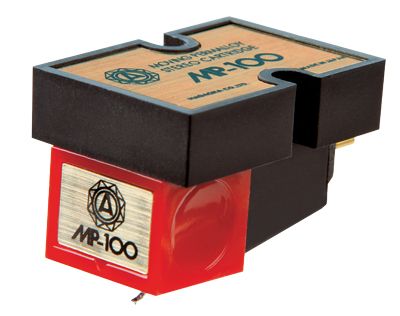Nagaoka Mp 100 (£70)

Enjoying a renaissance within the audio industry in recent years, Nagaoka now describes itself as a specialist processor for a range of hard-to-cut materials including jewels, ceramics, tungsten carbide and magnets. This portfolio clearly builds on its heritage as a manufacturer of the diamond styli fitted to its range of cartridges. The MP-100 is the entry level model of the range.
With this model you get a ‘superfine’ conical diamond tip attached via an alloy cantilever to a samarium cobalt magnet hinting at the other strings to the company’s bow. Moving up the Nagaoka range brings physical improvements such as boron cantilevers, elliptical and line contact stylus contours.
The simple, squared-off body of the MP-100 and its striking solid colour finish combine to give it a retro, almost Fisher-Price coolness and – more importantly – make alignment straightforward. The stylus is easily visible and Nagaoka has taken the time to factor in a recessed downward pointing arrow to the front face above where the cantilever exits, making alignment easier still. The recommended tracking force range is 1.8-2.3g – I settled on 2.1g after running the cartridge in.
WHERE'S THE PARTY?
The Nagaoka has an obviously forward presentation and is like the Audio-Technica in this respect, but what the Nagaoka also brings to the party is a bigger sense of fun. Beginning with ‘Get On Top’ from the Buckley LP, I was struck by the vibrancy of the lead guitar, joined shortly thereafter by the bongos which were one of the most energetically tapped and slapped within the group test. Cymbals were clear and fell away quickly adding to the pace, although they lacked the shimmer of the more expensive Benz Micro. However, more complex pieces with multiple instruments, such as the faster section within ‘Down By The Seaside’ became congested with Robert Plant’s vocals sounding slightly compressed.
Moving to the Mahler track the MP-100’s upbeat character breathed life into the gathering strings, emphasising their starts and stops. Overall though I felt much of the emotion was lost when playing this piece compared, say, to the Audio-Technica (its nearest price rival) and individual performances were not separated out to the same degree. The Nagaoka also had a tendency to smudge finer detail, especially in the upper bass and midrange frequencies, ‘White Chalk’ being a good example, where the soundscape soared with plenty of atmosphere but where individual strings of the zither sounded soft, rather than plucked.
Nor, during ‘Sweet Surrender’ – with the line ‘Surrender, surrender to love’ – was Tim Buckley’s impressive falsetto range honestly reproduced by the Nagaoka.
Originally published in the September 2011 issue



















































